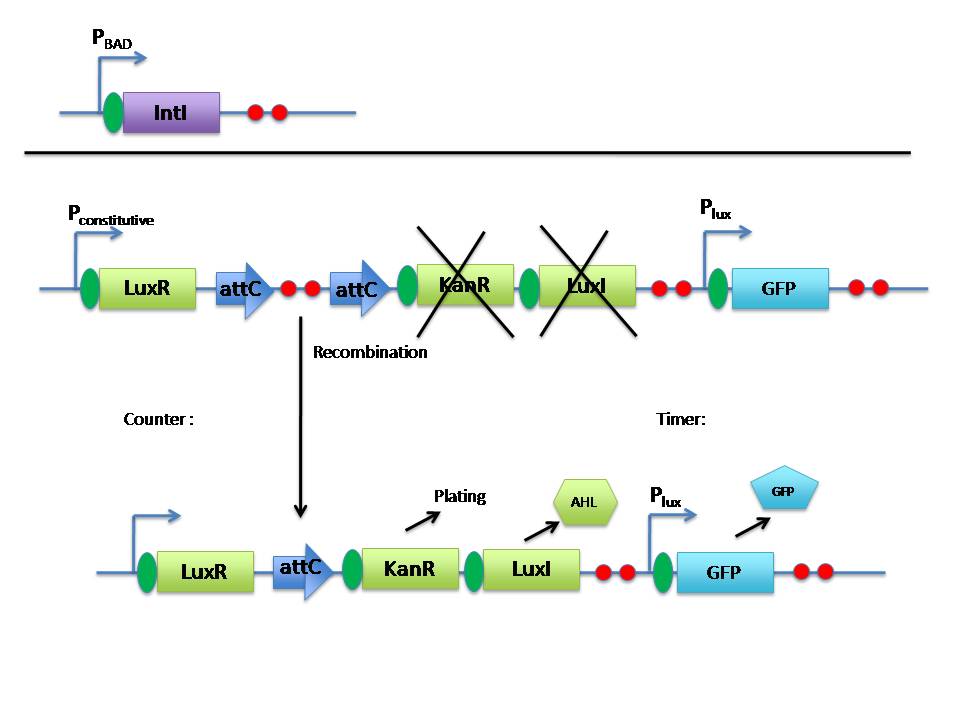Team:Paris Liliane Bettencourt
From 2010.igem.org
Aleksandra (Talk | contribs) |
Aleksandra (Talk | contribs) |
||
| Line 25: | Line 25: | ||
<br><br>Our second project is based on the capacity to make rare events happen in a number of cells of a population and the possibility to communicate. At each induction a few cells excise a terminator thanks to an integron. This excision provokes the expression of an antibiotic resistance downstream of a constitutive promoter. The proportion of resistant cells in the population reflects the number of induction pulses, which creates an event counter. At the same time, the induced cells express LuxI downstream of the constitutive promoter. When the proportion of induced cells reaches a certain level and the concentration of AHL exceeds a threshold the whole population starts expressing GFP, which creates a timer. To be able to count correctly, we have to control the conditions and wash away AHL from previous induction to produce a step function of its concentration. So we decided to use a microfluidic chemostat. | <br><br>Our second project is based on the capacity to make rare events happen in a number of cells of a population and the possibility to communicate. At each induction a few cells excise a terminator thanks to an integron. This excision provokes the expression of an antibiotic resistance downstream of a constitutive promoter. The proportion of resistant cells in the population reflects the number of induction pulses, which creates an event counter. At the same time, the induced cells express LuxI downstream of the constitutive promoter. When the proportion of induced cells reaches a certain level and the concentration of AHL exceeds a threshold the whole population starts expressing GFP, which creates a timer. To be able to count correctly, we have to control the conditions and wash away AHL from previous induction to produce a step function of its concentration. So we decided to use a microfluidic chemostat. | ||
| - | [[Image: | + | [[Image:populationcounter1.jpg]] |
[https://igem.org/Team.cgi?year=2010&team_name=Paris_Liliane_Bettencourt Team official Page] | [https://igem.org/Team.cgi?year=2010&team_name=Paris_Liliane_Bettencourt Team official Page] | ||
Revision as of 21:14, 16 July 2010
iGEM > Paris > Home > Synopsis from old template...
Memo-Cell
Abstract
Counting is the action of finding the number of elements in a set. Counting is a basic operation in electronic circuitry accomplished by the use of flip-flops, which are a type of digital device that has two stable states and can act as a single “bit” of memory for a counter.
Early efforts by synthetic biologists have shown that implementing this type of counter in cells is not easy. Since components in a cell are not strictly sequestered in the manner of electronic circuits, and since the cell signalling channels often interfere with each other in ways that are difficult to predict, digital methods seem like a problematic way to count in cells.
When looking to nature for inspiration, one finds mostly circuits that don’t actually count in a strict sense, but instead act as “threshold detectors” that cause something to happen after a certain threshold has been reached. Cell aggregation, telomere length regulation, and quorum sensing all fall under this category of device.
The method of counting in our project is capable both of true counting and of threshold detection, and is more similar to the mechanical counters invented in the late 19th century than to any digital circuit.
Our main project is designed to count on a cellular level. The cells include plasmids in their genome in a such way that the integration is sequential and controlled by a pulse of an input molecule. One pulse induces one integration. The integration is performed by an integrase which permits to integrate the whole plasmid in the genome. The plasmid carries one transposition site and one half of the integration site. The other half of the integration site and the second transposition site are present in the genome in multiple copies. When the plasmid is integrated both transposition sites are on the chromosome and the transposase cans excise the sequence in between. This creates a new full integration site and another plasmid can be integrated in response to the next input. The number of integrated sequences corresponds to the number of inductions and this number can be checked by PCR, which creates a counter.
This event recorder can also play the role of a timer thanks to a reporter gene placed after a predetermined number of integration sites. A screening system permits to kill the cells that don’t count correctly.
Our second project is based on the capacity to make rare events happen in a number of cells of a population and the possibility to communicate. At each induction a few cells excise a terminator thanks to an integron. This excision provokes the expression of an antibiotic resistance downstream of a constitutive promoter. The proportion of resistant cells in the population reflects the number of induction pulses, which creates an event counter. At the same time, the induced cells express LuxI downstream of the constitutive promoter. When the proportion of induced cells reaches a certain level and the concentration of AHL exceeds a threshold the whole population starts expressing GFP, which creates a timer. To be able to count correctly, we have to control the conditions and wash away AHL from previous induction to produce a step function of its concentration. So we decided to use a microfluidic chemostat.
 "
"
